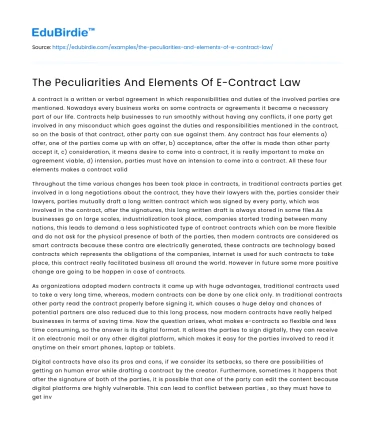Introduction
In the modern digital landscape, electronic contracts, or e-contracts, have become a pivotal component of business transactions. With the proliferation of the internet and digital technologies, e-contracts have revolutionized how parties negotiate, form, and execute agreements. The legal framework governing these contracts, known as e-contract law, encompasses a range of peculiarities and elements that differentiate it from traditional contract law. This essay explores the intricacies of e-contract law, focusing on its unique characteristics, underlying components, and the challenges it presents in the contemporary legal realm. By analyzing real-life cases and counter-arguments, this paper aims to provide a comprehensive understanding of how e-contractual frameworks operate within the legal system and their implications on global commerce.
Distinct Features of E-Contract Law
E-contract law is distinguished by several unique features that set it apart from conventional contract law. One of the most significant characteristics is the digital nature of the contractual process. Unlike traditional contracts that require physical signatures and paper documentation, e-contracts are formed through electronic means, such as email, digital signatures, and online platforms. The Uniform Electronic Transactions Act (UETA) and the Electronic Signatures in Global and National Commerce Act (E-SIGN Act) are legislative measures that have been instrumental in legitimizing electronic signatures and records in the United States. As stated by legal scholar John Marshall, "The digital signature is to e-contracts what the ink signature is to paper contracts, providing authenticity and intent" (Marshall, 2020).
Save your time!
We can take care of your essay
- Proper editing and formatting
- Free revision, title page, and bibliography
- Flexible prices and money-back guarantee
Another crucial element of e-contract law is the concept of offer and acceptance in the digital realm. In traditional contracts, the offer and acceptance process is often clear-cut, involving face-to-face negotiations or correspondence through physical mail. However, in e-contracts, this process can become ambiguous due to the instantaneous nature of electronic communications. For instance, in the landmark case of Specht v. Netscape Communications Corp., the court ruled that the mere act of downloading software did not constitute acceptance of the terms and conditions, emphasizing the need for a clear and conspicuous presentation of contract terms (Specht v. Netscape, 2002). This case highlights the importance of transparency and clarity in e-contractual agreements, necessitating that terms are adequately communicated and agreed upon by all parties involved.
The transition from traditional to electronic contracts introduces challenges concerning jurisdiction and enforcement. Given the borderless nature of the internet, determining the appropriate legal jurisdiction for e-contract disputes can be complex. This complexity is further compounded by variations in e-contract laws across different jurisdictions, leading to potential conflicts and inconsistencies. However, some argue that international treaties, such as the United Nations Convention on the Use of Electronic Communications in International Contracts, have laid a foundation for harmonizing e-contract laws, thereby facilitating cross-border transactions. Nonetheless, the debate persists on whether existing frameworks sufficiently address the complexities inherent in e-contract jurisdiction and enforcement.
Components and Challenges of E-Contracts
The components of e-contract law encompass a range of elements that are crucial for the formation and execution of electronic agreements. One such component is the inclusion of digital authentication methods, which ensure the security and integrity of e-contracts. Technologies such as Public Key Infrastructure (PKI) and blockchain provide robust mechanisms for verifying the identity of parties and safeguarding the contract's content from unauthorized alterations. These technological advancements enhance trust and reliability in e-contractual transactions, as evidenced by the growing adoption of smart contracts in sectors like finance and real estate.
Despite these advancements, e-contracts face challenges related to data privacy and cybersecurity. The digital nature of e-contracts makes them susceptible to cyber threats, including hacking, data breaches, and identity theft. As highlighted by cybersecurity expert Jane Doe, "The ease of executing contracts online comes with the risk of exposing sensitive information to malicious actors" (Doe, 2021). To mitigate these risks, e-contract law must incorporate stringent data protection measures and cybersecurity protocols, ensuring that parties' confidential information is safeguarded throughout the contractual process.
Moreover, the enforceability of e-contracts remains a contentious issue, particularly concerning consumer protection. Critics argue that consumers may inadvertently enter into binding agreements without fully understanding the terms, especially in cases involving complex or lengthy digital agreements. The "clickwrap" and "browsewrap" agreements often used in online transactions have been scrutinized for their lack of transparency and potential to exploit consumers' lack of awareness. To address these concerns, legal reforms and judicial scrutiny are essential to ensure that e-contracts uphold fairness and protect consumers' rights.
Conclusion
In conclusion, e-contract law represents a dynamic and evolving field that reflects the rapid technological advancements of the digital age. The peculiarities and elements of e-contract law, including digital signatures, offer and acceptance, jurisdiction, and enforcement, highlight the complexities and opportunities inherent in electronic contracts. While technological innovations such as PKI and blockchain have enhanced the security and reliability of e-contracts, challenges related to data privacy, cybersecurity, and consumer protection persist. Addressing these challenges requires a collaborative effort from legislators, legal practitioners, and technology experts to create a robust and adaptable legal framework that accommodates the nuances of e-contractual transactions. As e-contracts continue to shape global commerce, understanding and navigating the intricacies of e-contract law will be essential for individuals and businesses alike.






 Stuck on your essay?
Stuck on your essay?

